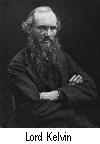HISTORY
What do fishermen, sailors, and mathematics have
in common? They all have an interest in knots, which have been used
at least since the beginning of history. Primitive, Egyptian, and
Greek societies used knots extensively. We know this through surviving
artwork and archaeological records. One interesting legend about
knots involves the Persian king Gordius; he dedicated a special wagon to
Zeus. He proceeded to tie the pole of the wagon to its yoke, creating
a knot so complex as to be seemingly impossible to untie. Then the
oracle of Zeus pronounced that whoever could untie the knot could be the
king of Asia. After many attempts to untie the knot, Alexander
the Great cut the knot with his sword, and announced that he
would rule Asia with his sword.
 Mathematics
has found that knots are not always possible to untie without cutting them,
like Alexander the Great opted to do. Studying knots in mathematics
began about 100 years ago, when scientist Lord Kelvin theorized that all
atoms were simply knotted vortices in ether, a fluid which filled all space.
This prompted scientists to try to classify all knots, in order to understand
atoms better. When Kelvin's theory was invalidated by the atomic
revolution, knot theory went by the wayside in most fields. Consequently,
knot theory was thought to be fairly unhelpful to other fields for many
years. However, some mathematicians continued to study knots, and
in the 1980's, knot theory was discovered to have useful results in the
fields of molecular biology. DNA, scientists postulated, sometimes
tangled into interestingly shaped knots, which, if understood could lead
to revolutionary discoveries about the mechanisms of DNA replication.
Mathematics
has found that knots are not always possible to untie without cutting them,
like Alexander the Great opted to do. Studying knots in mathematics
began about 100 years ago, when scientist Lord Kelvin theorized that all
atoms were simply knotted vortices in ether, a fluid which filled all space.
This prompted scientists to try to classify all knots, in order to understand
atoms better. When Kelvin's theory was invalidated by the atomic
revolution, knot theory went by the wayside in most fields. Consequently,
knot theory was thought to be fairly unhelpful to other fields for many
years. However, some mathematicians continued to study knots, and
in the 1980's, knot theory was discovered to have useful results in the
fields of molecular biology. DNA, scientists postulated, sometimes
tangled into interestingly shaped knots, which, if understood could lead
to revolutionary discoveries about the mechanisms of DNA replication.
>Next
page






kMain
menu 1.
History
2.Intro
3.Invariants 4.Composition
5.Conclusion
 Mathematics
has found that knots are not always possible to untie without cutting them,
like Alexander the Great opted to do. Studying knots in mathematics
began about 100 years ago, when scientist Lord Kelvin theorized that all
atoms were simply knotted vortices in ether, a fluid which filled all space.
This prompted scientists to try to classify all knots, in order to understand
atoms better. When Kelvin's theory was invalidated by the atomic
revolution, knot theory went by the wayside in most fields. Consequently,
knot theory was thought to be fairly unhelpful to other fields for many
years. However, some mathematicians continued to study knots, and
in the 1980's, knot theory was discovered to have useful results in the
fields of molecular biology. DNA, scientists postulated, sometimes
tangled into interestingly shaped knots, which, if understood could lead
to revolutionary discoveries about the mechanisms of DNA replication.
Mathematics
has found that knots are not always possible to untie without cutting them,
like Alexander the Great opted to do. Studying knots in mathematics
began about 100 years ago, when scientist Lord Kelvin theorized that all
atoms were simply knotted vortices in ether, a fluid which filled all space.
This prompted scientists to try to classify all knots, in order to understand
atoms better. When Kelvin's theory was invalidated by the atomic
revolution, knot theory went by the wayside in most fields. Consequently,
knot theory was thought to be fairly unhelpful to other fields for many
years. However, some mathematicians continued to study knots, and
in the 1980's, knot theory was discovered to have useful results in the
fields of molecular biology. DNA, scientists postulated, sometimes
tangled into interestingly shaped knots, which, if understood could lead
to revolutionary discoveries about the mechanisms of DNA replication.
